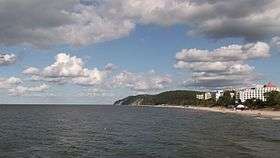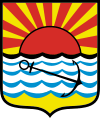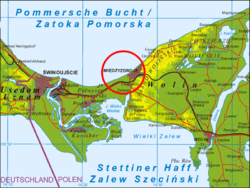Międzyzdroje
Międzyzdroje (pronounced ['mʲɛnd͡zɨˈzdrɔjɛ][2][3]; German: Misdroy; Kashubian: Mizëzdroje; Swedish: Misdroy) is a town and a seaside resort in northwestern Poland on the island of Wolin on the Baltic coast. Previously in the Szczecin Voivodeship (1975–1998), Międzyzdroje has been in Kamień Pomorski County in the West Pomeranian Voivodeship since 1999. Międzyzdroje has a population of around 5,500 (2016).[1]
Międzyzdroje | |
|---|---|
 Beach in Międzyzdroje | |
 Coat of arms | |
 | |
 Międzyzdroje | |
| Coordinates: 53°55′37″N 14°27′2″E | |
| Country | |
| Voivodeship | West Pomeranian |
| County | Kamień |
| Gmina | Międzyzdroje |
| Established | 15th century |
| Town rights | 1945 |
| Government | |
| • Mayor | Mateusz Bobek |
| Area | |
| • Total | 4.51 km2 (1.74 sq mi) |
| Population (2016) | |
| • Total | 5,443[1] |
| Time zone | UTC+1 (CET) |
| • Summer (DST) | UTC+2 (CEST) |
| Postal code | 72-500 |
| Area code(s) | +48 91 |
| Car plates | ZKA |
| Website | Międzyzdroje |
The town is often referred to as The Pearl of the Baltic. It is situated between wide sandy beaches with high cliffs and the forests of the Woliński National Park (which includes a bison reserve). Międzyzdroje has a spa climate and is rich in tourist services.
History
Towards the very end of the 12th century two settled camps or settlements have been established within the present-day borders of the town. Both of these settlements, with a mining and agricultural focus, were property of the bishopric of Kamień Pomorski. The first initial name of the town appeared in the 15th century as Misdroige.[4][5] According to sources, the early Slavic and Germanic settlers were involved primarily in agriculture, cattle-breeding, fishing, bee-keeping and hunting.[5]
A tragic part in the history of the Pomerania region and Międzyzdroje (Misdroy) was the Thirty Years' War. It was then that the entire island of Wolin fell under the rule of the mighty Swedish Empire. In 1715 the island was annexed by Prussia due to a peace agreement made in Stockholm.[5] A particularly noticeable increase in the number of inhabitants, mostly local but also foreign, was recorded throughout the 18th century. During this time, the village began to evolve into a luxurious spa resort as a result of strong English influence in the development of sea baths.[4]
In the first half of the industrial 19th century, Europeans of different backgrounds began to visit Misdroy and appreciate its baths, health clinics and favourable climate. With the arrival of tourists and the development of the tourist sector in the area, the once small, insignificant fishing village rapidly transformed into a popular health resort. In 1835,[5] the gender-segregated baths were constructed by English and German merchants and entrepreneurs. Wealthy industrialists and business magnates from Stettin (Szczecin), Berlin and London would erect their magnificent and extravagant villas along the Baltic shore.[4]
One of the earliest public park was created in 1860 as an initiative of a wealthy Belgian merchant named Arnold Lejeune.[6] A wooden pier on the Baltic sea was constructed and eventually upgraded in 1906. The pier was 360 metres in length and the coffee-house situated at its very end still operates to this day.
In 1899, Misdroy was connected via railway with nearby Szczecin (Stettin) and Świnoujście, which contributed to an even greater number of patient and tourist arrivals. Shortly before the outbreak of World War I, over 20,000 visitors were recorded,[4] an astonishing and record-breaking number in that period.
20th century
Prior to World War II, Misdroy had around 4,000 permanent residents. It did not suffer destruction during the course of the war. After the shifting of Poland's borders by the Soviet Union, Międzyzdroje became part of the People's Republic of Poland in 1945 and was granted town status.
The town's Polish name comes from its original 16th century meaning of the "town between salts springs", or Międzyzdroje in Polish.[7]
International relations
Międzyzdroje was the birthplace of the Harvard World Model United Nations Conference in 1991.
Międzyzdroje is twinned with:[8]







Notable residents
- Ernst Eiselen (1792 - 1846 in Misdroy) a German gymnast and a promoter of the Jahn style of gymnastics [9]
- Hermann Wilhelm Ebel (1820 – 1875 in Misdroy) was a German philologist [10]
- Albert Sauer (1898–1945), German Nazi SS concentration camp commandant
- Prince Claus of the Netherlands (1926–2002) husband of Queen Beatrix, he attended the Baltenschule Misdroy from 1938 until 1942
External links
| Wikimedia Commons has media related to Międzyzdroje. |
| Wikivoyage has a travel guide for Międzyzdroje. |
References
- "Międzyzdroje » mapy, nieruchomości, GUS, szkoły, kody pocztowe, wynagrodzenie, bezrobocie, zarobki, edukacja, tabele". Polskawliczbach.pl. Retrieved 1 November 2017.
- Salter, Mark; Bousfield, Jonathan (2002). Poland. Międzyzdroje. Rough Guides. pp. 55, 596. ISBN 1858288495.
- Insight Guides (2015). Insight Guides Poland. Międzyzdroje. Apa Publications (UK) Limited. p. 575. ISBN 1780055366.
- T. Gajewski. "Apartament Miedzyzdroje – Vanessa". Apartament-Miedzyzdroje.info.pl. Retrieved 2 November 2017.
- StayPoland. "History of Miedzyzdroje". www.staypoland.com. Retrieved 1 November 2017.
- "Atrakcje". start. Retrieved 1 November 2017.
- Malinowski, Maciej (16 August 2006). "Dlaczego (te) Międzyzdroje?". ObcyJezykPolski.pl.
Nazwa Międzyzdroje z pewnością etymologicznie oznacza to, co ‘znajduje się między zdrojami, czyli miejscami ziemi, skąd wytryskuje woda, solanka’, i początkowo określała ‘osadę położoną między zdrojami’ (od XIX wieku miejscowość stała się uzdrowiskiem kąpielowym właśnie dzięki solankom). Nazwę miejscowości zrekonstruowano na podstawie XVI-wiecznego niemieckiego zapisu Misdroy, Misdroye – twierdzi prof. Jan Miodek.
- "Miasta partnerskie". miedzyzdroje.pl (in Polish). Gmina Międzyzdroje. Retrieved 2019-10-22.
- . New International Encyclopedia. 1905.
- . Encyclopædia Britannica. 08 (11th ed.). 1911.

